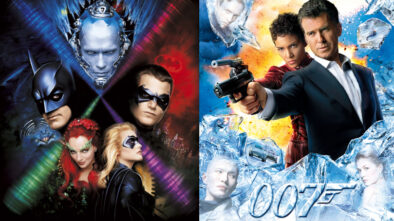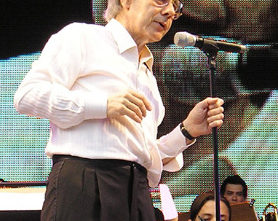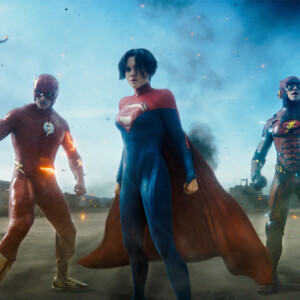Mission: Implausible–The Making Of M:I’s Spectacular Bullet Train Sequence
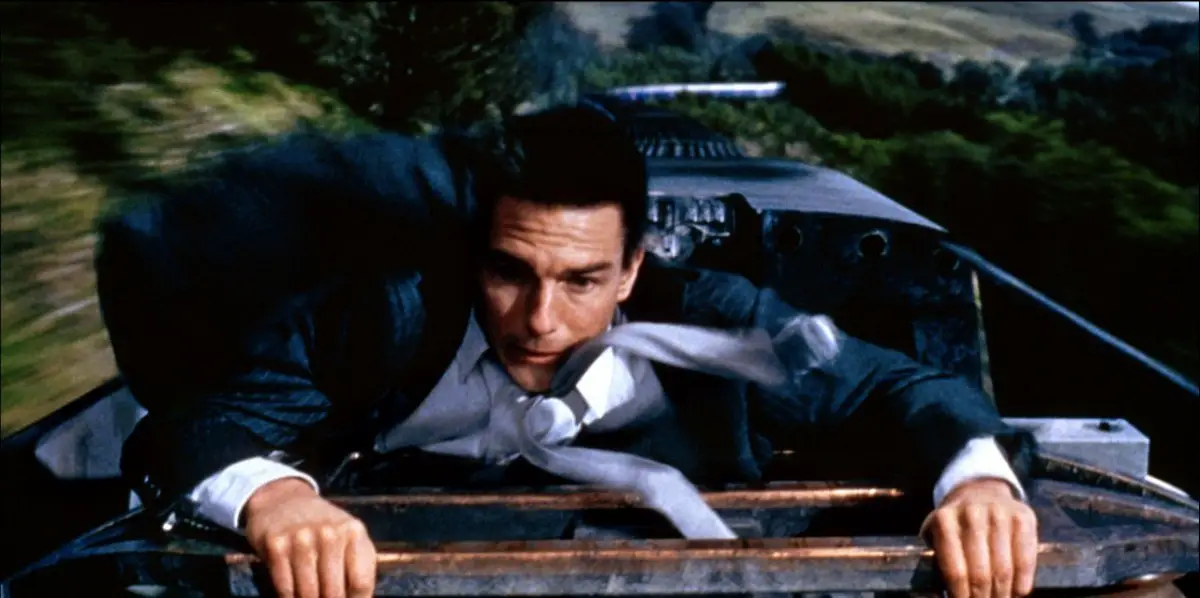
Source: Paramount Pictures via MovieStillsDB.com
Learn the full story behind Mission: Impossible’s bullet train sequence from ILM’s visual effects supervisor, John Knoll, and digital effects artist, Stu Mashwitz. Plus, discover how they researched the formula for creating a great action sequence, and how Tom Cruise made that incredible leap from an exploding helicopter onto the bullet train.
Mission: Impossible is surprisingly devoid of stunts, favoring an intricate plot that feels like a cross-between a whodunit and a Cold War thriller. Nonetheless, the film switches gears in the third act with its outrageous bullet train sequence. The sequence begins with an improbable scuffle between IMF agent Ethan Hunt (Tom Cruise) and Jim Phelps (Jon Voight) on top of a TGV bullet train. If the fight on top of a train moving at 200 mph doesn’t challenge realism, then the sequence’s climax in the Channel Tunnel certainly does. In a moment that defies physics, Ethan Hunt is propelled by an exploding helicopter onto the back of the bullet train.
The outrageous idea works spectacularly in the film and is a standout moment in the M: I franchise. Interestingly, Cruise initially argued against the helicopter stunt, believing it would make the film too unrealistic. But once he performed the stunt, he was hooked. For every successive M: I film, Cruise devised stunts more outrageous and more dangerous than the last.
A Combination of Live-Action, Model Work, And CGI
Industrial Light and Magic, the pioneering VFX studio that invented modern special effects, created the sequence. On Mission: Impossible, ILM exercised restraint in using CGI. By the mid-1990s, filmmakers had become more and more reliant on CGI, often with mixed results. Early CGI often looked plastic, especially in the rendering of digital humans. While digital humans looked more realistic with each new film, they still mostly erred into uncanny valley, a problem still prevalent in recent films.
John Knoll, ILM’s visual effects supervisor on Mission: Impossible, avoided this pitfall by combining CGI with live-action, and old school miniatures. Knoll’s team limited the use of CGI, especially in augmenting Cruise. The real Cruise featured in all live-action components of the bullet train sequence, including that hair-raising jump from the exploding helicopter onto the back of the train.
Although TGV gave Cruise permission to shoot on top of their fastest train, it quickly became apparent the majority of the sequence needed to be filmed under a controlled situation on a soundstage. Apart from some exterior shots, the crew primarily shot the sequence over six weeks in the 007 Stage at Pinewood Studios, London. ILM, on the other hand, did most of the sequence’s effects work in their parking lot in San Rafael, California.
Most of the Pinewood shoot featured Cruise and Voight tussling on the top of life-size models of two TGV train carriages with a wind machine creating the wind-swept look of traveling at 200 mph. Cruise, Voight, and Jean Reno also filmed on a life-sized helicopter. All these shots were filmed in front of a blue screen, later filled in with ILM’s effects work. The effects included a CG helicopter and CG train used for exterior shots over the British countryside. ILM created the action inside the tunnel with a mix of CG assets, 1/8 scale miniature environments, a train miniature, and helicopter models rigged with explosives. Knoll also pioneered a new technique called projection mapping to simulate the effect of the background zooming past at 200 mph.
It’s a lot to unpack. A ton of work went into creating the bullet train sequence. Creating this mix of practical and visual effects was difficult and time-consuming, and the stunt work and logistics of the shoot taxed both cast and crew alike.
But this is the price of crafting a memorable action sequence. And both Knoll and director Brian De Palma wanted nothing less than the best.
What Makes An Action Sequence Great?
According to Cinelinx, Knoll and De Palma researched two of the great action films, Raiders of the Lost Ark and Terminator 2: Judgement Day, for inspiration. Sequences, such as Indiana Jones chasing the Nazi truck carrying the Ark and the truck pursuing John Connor through the canal in Raiders and T2 respectively, provided key insights into the structure of a great action sequence.
These sequences revealed that every element in a great action sequence (including camera shots, vehicle speed, music, and the timing of the stunt) is well choreographed together. Altogether, these elements combine to provide a suitable payoff for the audience and help turn a good sequence into a great one.
But unlike Raiders and T2, the majority of the train sequence is not shot on location and relied heavily on a soundstage, miniatures, and visual effects. Knoll and the rest of the crew at ILM had to bring their A-game to this sequence in order to bring a level of realism that made the on-location footage indistinguishable from the effects and soundstage footage.
While Knoll and his team created the most realistic effects possible, De Palma decided to limit the use of music for the first few minutes of the sequence to focus on sound effects. The sound of air rushing by at 200 mph helped set the tone for the sequence, and sell its realism. This directorial choice also helped build the scene up to its crescendo when Cruise finally jumps onto the helicopter’s landing skid and the familiar Mission: Impossible theme music emphasizes the climactic payoff.
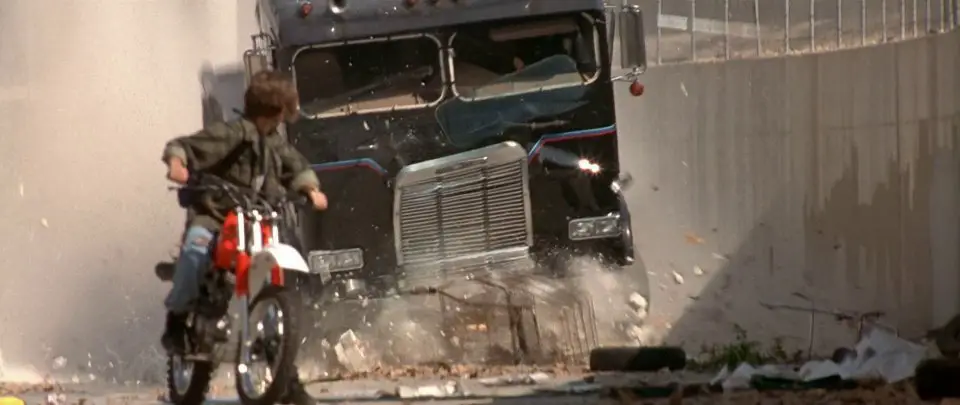
The T-1000 chases John Connor through the canal in Terminator 2.
From Storyboards to Animatics
To help choreograph these elements, Knoll initially worked with De Palma to storyboard the complex sequence. From his work on Star Trek: Generations (1995), Knoll recalled the limitations of storyboarding correct perspectives for complex FX elements in a shot. To solve this on Star Trek, Knoll had built simple CG models and then did the shot design in 3D “so then I’d know for sure that any shot I designed would be correct.”
Knoll soon found it necessary to follow a similar approach on Mission: Impossible.
“[When De Palma] wanted a list of all the camera focal lengths and positions, so there was no guessing on the stage, it seemed like the natural way to do that was to have a CG model of the train and helicopter, and layout those shots in perspective-correct 3D. I did a first pass on that and then, after I had done stills reproducing the storyboards, Brian requested running footage with animatics. This was just like a previs, and it worked tremendously in helping us make the sequence.”
Making the Outrageous Follow the Law of Physics
Making the bullet train sequence look good on paper and in animatics was quite different from making it look good in the final sequence. In fact, it was extremely difficult. According to Knoll, Cruise was involved in pre-production on Mission: Impossible, making sure that shots were staged in such a way that the audience knew he was really doing the stunt.
This also meant ILM needed to make sure the combination of live-action and effects didn’t make Cruise look silly. While the physics of the bullet train sequence gets more ridiculous as the scene progresses, Knoll knew it had to look right on screen to the audience. In a recent interview with Light The Fuse podcast, he said:
“Even if audiences can’t tell you what is technically wrong with a shot, if you don’t get the physics right, they can see that something looks wrong. They might not be able to say, ‘Oh well it’s because that object isn’t following a ballistics trajectory.’ It looks wrong to them. So I think it’s always important for us to do our homework, and try and enforce as much scientific rigor on the work that we’re doing as is appropriate. Obviously we do a lot of fantasy things that are theoretically impossible, but I always try to [think], ‘Well if this were real, if there were some mechanism behind it, what would that look like? And I try and let that drive the work.”

Brian De Palma and John Knoll disagreed on the physics of the train sequence. Source: Wikipedia
Knoll added that even he had misgivings about some of De Palma’s requests for the sequence:
“I do remember there was a moment where we’re obviously putting Ethan into a lot of peril in that train sequence and there’s a moment where he’s hanging off the side of the train, and there’s another train coming, and he’s about to get scraped off the side of the train. And Brian wanted Tom to be hanging on the side of the train and then sort of tipped up completely horizontal [even though in normal physics] the drag and the wind would have been pulling him sideways. And I was trying to explain, ‘Well I think he should be at a bit of an angle because if you think about the vector math here, the gravity’s pulling him this way, and then the air drag is pushing him this way. You wouldn’t get completely horizontal.’ And Brian didn’t have a lot of patience for that kind of stuff. He said, ‘We’re making a movie. This is not a physics lesson. Get a life.'”
Leaping Into Action
Tom Cruise was more than prepared to shoot on top of a real train for part of the stunt. He petitioned TGV to use their French train, which was the fastest in the fleet. But rail authorities initially wanted no part in the stunt. When they finally agreed, the track was unavailable, and De Palma opted to shoot exterior shots on the Glasgow South Western Line instead.
However, the crew shot the majority of the sequence on the soundstage at Pinewood. Cruise, who also produced the film and who was prepared to go to great lengths and personal risk to make the sequence as real as possible, sought out a wind generator that produced a 140 mph wind velocity. The generator, of course, gave Cruise the wind-swept look of traveling at 200 mph. Not only did it blow back his hair and distort his face, but the actor also used it to help propel him from the helicopter onto the back of the bullet train that forms the climax of the sequence. “I ended up doing it three or four times and it hurt – I was black and blue for days. But I wanted to make it real, to make it believable,” Cruise recalled.
For the shot where Ethan Hunt is flying towards the camera, Cruise was also aided by a wire as he was moved steadily towards the camera.
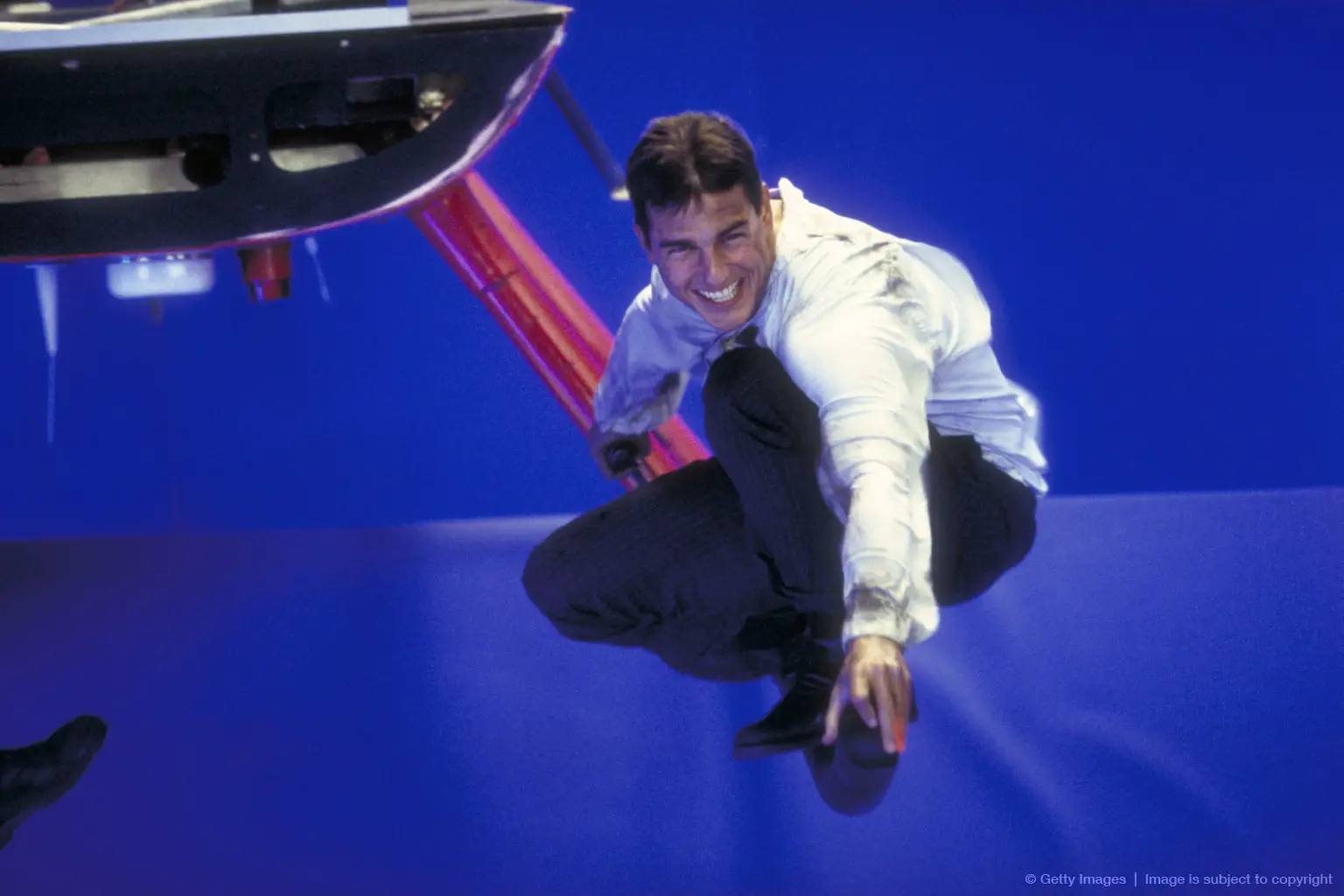
Source: Paramount Pictures via MovieStillsDB.com
While making the leap certainly had its dangers, the high-speed velocity of the wind machine could prove life-threatening, even for relatively safe shots of Cruise lying on top of the train. A small particle could suddenly become as deadly as a bullet if shot out of the machine at 140 mph. So extra precautions were taken with the adoption of a multi-level filtration system.
Still, nothing could prevent Cruise from getting the best take.
Stu Mashwitz, a digital effects artist on the film, recalled Cruise’s courage and commitment to filming the sequence on the Light the Fuse podcast:
“Tom Cruise would be hooked into some kind of wire harness. Like there’s that crazy shot where he kind of winds up flipping up and over and landing on his belly facing the other direction on the train and the camera pushes in on him, to kind of show that it’s him. It’s awesome and it’s insane. And of course it’s got wire-work that has to be painted out. An amazing kind of job of tracking and all that kind of stuff. But the other thing, it’s Tom Cruise doing this crazy flip thing, and landing on his gut on this set. And after every single take, he would have the stunt crew unhook all of his wires, he would climb down off the train, he would go over to the monitor and watch the playback with everybody: John and Brian and everybody. And like study it and say, ‘Okay, I can do it better. I can make it look better.’ And he’d be back up there, not even asking anybody if they thought they had the take they wanted. And John said he’s standing next to Tom Cruise and Tom Cruise has these open slits in the side of his shirt for the cables that are hooked into his harness. And John is like looking at Tom, and Tom is bleeding. He’s got cuts and scrapes and he’s bleeding. And he’s like, ‘Okay guys let’s do it again.’ So I didn’t realize it at the time, I was seeing the kind of the origin story of Tom’s relationship to the stunts in these movies.”
With Cruise’s wire-work looking good, it was now up to ILM to fill in the background elements, helicopter shots, and its final explosion and collision with a model TGV train carriage.
Adding Fast Moving Environments
Filling in the blue screen with realistic environments was no small feat for ILM. There were exterior shots of the British countryside and interior shots of the tunnel.
The interior shots were a mixture of CG and model effects, but the exterior also had many effects that had to be integrated seamlessly with the on-location shots of the countryside. The exterior shots were real footage filmed in Scotland, as were the fore and aft POVs of the train. Wider exterior shots, ILM composited in its CG train along the real train tracks.
The countryside whizzing by 200 mph required a different approach than the matte paintings used for exterior shots in many films of the time. But in this train sequence, Knoll and his team were faced with the additional factor of high-speed movement. The countryside and the tunnel interior are whizzing past at 200 mph and look different from different perspectives and camera angles.
Projection Mapping For Exterior Shots
To resolve this problem, Knoll used projection mapping, a new technique he employed on Hook and Terminator 2. However, for Mission: Impossible he used the technique more extensively.
Knoll had a friend at Electric Image create a plugin for projection mapping. As Knoll explained to VFX Blog, projection mapping allowed him to warp a photograph of a real outside environment and also the CG tunnel walls to simulate it whizzing by at 200 mph.
This is very effective in the exterior shots of the British countryside because it seamlessly merges with the shots filmed on location.
To add even further realism, the camera’s viewfinder was often obscured by trees and bridges to give the effect the sequence was filmed on location from a car or helicopter speeding alongside the TGV, rather than motionless on a soundstage. Even well-timed shakes and bumps to the camera were used to sell scenes filmed in front of the blue screen (a trick that, of course, was extended into shots filmed in the interior of the tunnel).
With the addition of the wind machine blowing in Cruise’s face, he really does look like he’s on top of a train hurtling at 200 mph.
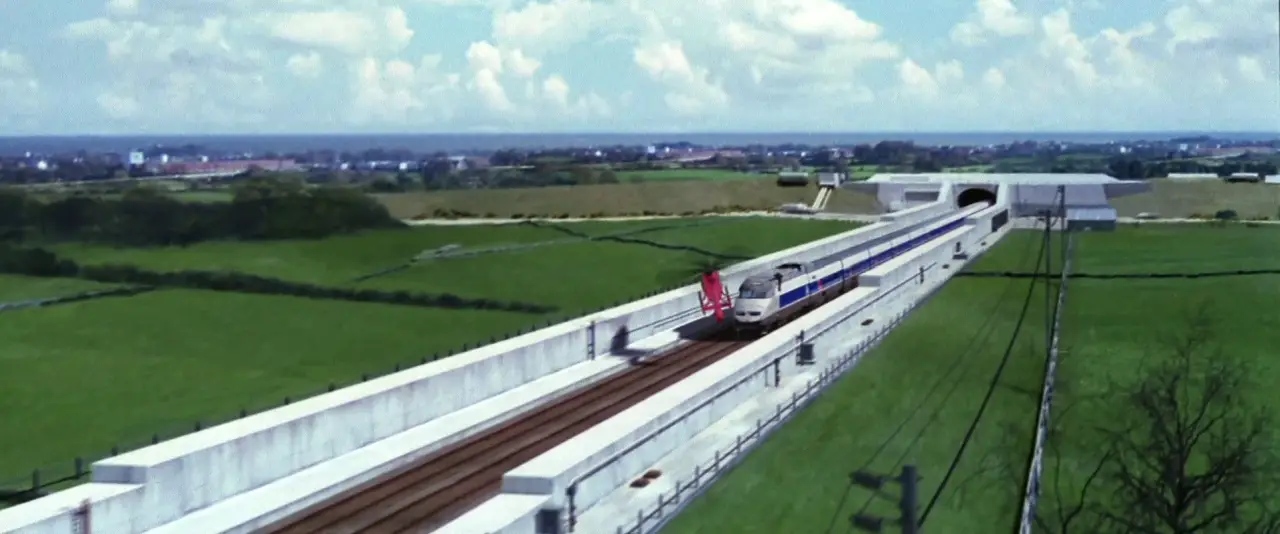
A CG train towing a CG helicopter into a CG Chunnel. These CG elements were composited onto real train tracks in this wide shot of a real Scottish countryside Source: FILM-GRAB
Simulating Speed In A Miniature Tunnel
For shots inside the tunnel, ILM used the combination of a CG interior and a 1/8 scale miniature of the tunnel. The miniatures of the tunnel, the train, and the helicopter were shot on the backlot of ILM’s office in San Rafael. A camera traveling through it on a track helped simulate the speed of the train.
Even though they’re miniatures, 1/8 scale still takes up a fair bit of space. The model helicopter was about four feet long and the tunnel was approximately six feet across, and about 155 feet long. Knoll told Light the Fuse:
“What we ended up doing is building a 600-foot-long steel rail. A track that the camera could run back and forth on. And we had a great big electric winch…And the camera and the helicopter and the train were all mounted in different places on the rail. And this winch would accelerate the camera up to speed. So you can imagine 400 feet of track before you get to the tunnel. And then the tunnel is 150 feet of that. And then 50 feet out the back end of the tunnel is basically our break for deceleration.”
Additionally, a model helicopter was shot at a higher frame rate so that the speed of the motion looks correct, which also helped it look full scale. This meant shooting the 8th scale miniature at 72 frames a second.
“So the train’s already supposed to be going fast and then because you’re running at a higher frame rate you have to make it go even faster than that,” said Knoll. “So I think in the end the camera had to be going 50 miles an hour through that tunnel for all the numbers to work and for it to look right. And so accelerating a camera up to 50 miles an hour is no small task.”
One Helicopter, Multiple Models
A variety of different helicopters were used for the sequence. De Palma and ILM selected a McDonnell Douglas MD520 No-Tar (or ‘no tail rotor’ helicopter), which only came in red or black. Red was chosen because black would be more difficult to see in the tunnel. Cruise, Voight, and Reno shot their scenes on the No-Tar on the soundstage at Pinewood, after it had been shipped from location shooting in Scotland’s countryside.
Shooting the No-tar on location had been a bit of a failure because the footage could not keep up with the speed of ILM’s CG train. This real footage may not have matched the digital, but it, nonetheless, provided a stockpile copter reference, which matched seamlessly with ILM’s handpainted textures.
“People can’t believe that’s not a real helicopter,” Knoll told American Cinematographer (Dec. 1996). “It doesn’t look the tiny bit synthetic.”
This real helicopter footage blended in with ILM’s combination of CG models and scale models used for the rest of the sequence.
Knoll wanted to do the shots with the helicopter as practically as possible. Initially, the use of a CG helicopter was not planned, but it soon proved a necessity, as Mashwitz revealed:
“If you take kind of a typical shot looking back down the train, the terrain is whipping by. The whole point is its the TGV so its going 200-something miles per hour. And so the idea was that they’d actually shoot two plates…It was all basically going to be split screens. So they would shoot the helicopter at 24 frames per second doing its performance, and then the train tracks whipping at like six frames per second. And then they would be split together. And that immediately kind of fell apart because an under-cranked helicopter looks bad. So the split was necessitated but the split required perfectly straight train tracks which they could almost never find and it was boring to look at when they did find it. And they couldn’t get the practical helicopter close enough to the camera to get the dramatic angles that the sequence called for.”
The CG helicopter gave ILM the flexibility they needed. In the final sequence, the CG asset is being towed by the train into the tunnel, and inside the tunnel, it’s used right up to the moment Ethan Hunt jumps onto the landing skid.
Blowing Up Helicopters (Repeatedly)
CG had its limits at the time. Exploding CG helicopters just weren’t up to scratch, and Knoll didn’t even attempt it. For the entirety of the helicopter’s explosion and its subsequent tumble down the track into the back of the train, scale models were used. These scale models were so expensive that only two were built.
The crew mounted a carriage rig with a camera and the model at a fixed distance. This allowed both the camera and the model to remain at a fixed distance as the carriage rig moved along the track down the tunnel. Every day the helicopters were blown up, in two takes. And then every night crew had to rebuild and repaint the models to go through the same process the next day.
The whole process was painfully slow by today’s standards, but Mashwitz said that the more the model was rebuilt, the better it would blow up.
“I’d go to these VistaVision dailies and you’d see like Steve Gollies hand in agonizing slow motion releasing from the helicopter and then all of a sudden everything would start moving and it took forever. A ten second take takes minutes to watch. And then also there’d be this sweet spot where it looked absolutely, totally realistic, and then the helicopter would blow up in some beautiful way and then the arm would retract and then the helicopter would catch on the arm and it would do something stupid and everyone would be, ‘Ok we’ll go back today and fix it.'”
The whole process of shooting the helicopter traveling through the miniature tunnel and then blowing it up was complex. First, the crew was limited to shooting at night because the large size of the miniature tunnel made it difficult to blot out the daylight. In addition, the movement of the train and helicopter, the illusion of space in the tunnel, and the helicopter’s explosion all had to be well-timed. As such, the model helicopter and camera activated two micro-switches along the track.
“What happens when you’re looking down the tunnel. Well, you’ll just see the end of the tunnel right? So we took a still photograph at one end of the tunnel and we made a big six foot wide blow up of it, and it was basically set up like a trap door … So [when the camera and the helicopter] was accelerating on 600 feet of track, and when it finally got into the tunnel it clicked a micro-switch which opened a solenoid and dropped this still photo … extending the tunnel off into the distance. And then another micro-switch would fire off the pyro to blow up the helicopter and it was kind of controlled that way.”
Sources:
Cinelinx
“The Impossible Dream”. Toronto Sun (May 19, 1996)
“Handling an impossible task A ‘Mission’ complete with intrigue” USA Today (May 22, 1996)
Light the Fuse Podcast
VFXBlog




